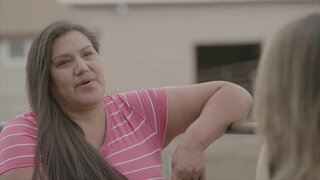Create a free profile to get unlimited access to exclusive videos, breaking news, sweepstakes, and more!
'It's Staggering To Think About': Loni Coombs Discusses How To Help With The Cases of Missing And Murdered Indigenous Women
"Eight-four percent of Native American women will experience violence in their lifetime," Loni Coombs, an investigative journalist and former criminal prosecutor featured in the new Oxygen special "Murdered And Missing In Montana," said.
While looking over the statistics related to Indigenous women and violence, a disturbing portrait emerges.
"Eighty-four percent of Native American women will experience violence in their lifetime. Ninety-four percent of Native American women will be raped or coerced in their lifetime. ... It's staggering to think about it, to even be able to comprehend those numbers, it's overwhelming, and I think sometimes people just get desensitized to it because it's just so staggering," investigative journalist and former criminal prosecutor Loni Coombs, who is featured in Oxygen's new special "Murdered And Missing In Montana," which focuses on the disappearance and mysterious deaths of three Indigenous girls in Montana, told Oxygen digital correspondent Stephanie Gomulka.
RELATED: The Murdered And Missing Indigenous Women Crisis Explained
These shocking numbers reflect a dismal and horrific reality for Native communities. It's a crisis that's explored in depth in "Murdered And Missing In Montana."
Beyond Montana, advocates nationwide are pushing for justice for murdered and missing Indigenous women.
Changes are already being made at the federal level. In October 2020, Savanna's Act was passed by Congress. The legislation "requires the federal government to update information relevant to Indigenous people and improve tribal access to local, regional, state, and federal crime databases. It also mandates the creation in collaboration with tribes of standard protocols for responding to MMIP cases," according to a Wyoming report. This will aim to tackle the issues of misidentification of victims and an overall lack of data.
In March 2021, Deb Haaland became the first Native American appointed as a Cabinet secretary when she was confirmed as Secretary of the Interior (which oversees the Bureau of Indian Affairs). She's recently set up a Murdered and Missing Unit to pursue justice for Indigenous communities.
Coombs also has ideas for what can be done to help support Native American women.
"First of all, with the missing persons cases, you know we saw in the Gabby Petito case how much media coverage can really impact a case ... but the problem with that is usually the people who determine what stories get covered by the mainstream media or law enforcement has not been interested in covering Native American women's cases — and if they do, they're portrayed in negative ways," she said.
Abigail Echo-Hawk, chief research officer for the Seattle Indian Health Board and an enrolled member of the Pawnee Nation of Oklahoma, made a similar point in an interview with CNN.
"[Indigenous women] are assumed to have been killed, murdered or disappeared. They're assumed to have run away, to have had substance abuse issues, to have done something that caused them to go missing or to be murdered," she told the outlet.
And the data speaks for itself. In Wyoming, only 18 percent of homicide cases involving Indigenous women victims get newspaper coverage — as opposed to 51 percent for white female and male victims, according to a state report. This behavioral pattern, often called Missing White Women Syndrome and coined by the journalist Gwen Ifill, refers to idea that the amount of media coverage and general attention a victim will get is directly related to their racial and ethnic background and other demographics, according to The Great Falls Tribune.
It's not just traditional media that now affects these cases, Coombs noted. Social media can also play a big role, and that's where ordinary people can make an impact.
"We also saw in the Gabby Petito case that social media, which we all have our own phone, it can also make a big difference. So, we can go on our Instagram or Twitter or Facebook and look up these cases and see what's going on," Coombs said.
You can also get involved directly in the search yourself, Coombs suggested.
"If there's someone going missing in your area, get involved in the search, get involved in the rally about this to provide more insight and more of a spotlight on it. If it's not in your area, download the missing posters and put them up in your area ... a lot of times these women go missing outside the reservation, and we need to be able to cover all areas of the United States," Coombs stated.
Coombs also emphasized the importance of education when it comes to these issues.
"We also just need to be talking about understanding the things that make these women targets of such violence, educating ourselves about that .., When there aren't positive representations out there it's easier for people to see Native American and Indigenous women as less than worthy, as less than human, as less than valuable enough to be looked for, to be protected," she explained.
For more on Coombs' interview with Gomulka, watch the video above. And watch "Murdered And Missing In Montana" on Oxygen or stream the special here.






















